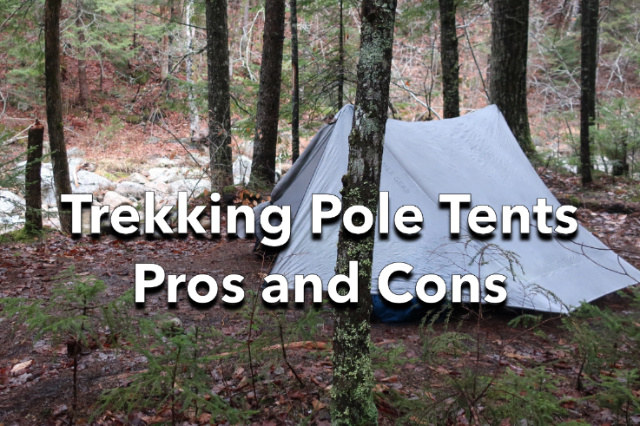
Trekking pole tents use hiking poles for setup instead of tent poles as a weight-saving measure for backpackers. They’re also a good example of how to use the same backpacking gear in multiple ways, one of the core principles of gear weight reduction for ultralight backpacking.
Trekking Pole Tent Strengths
If you already carry trekking poles, switching to a trekking pole tent from a tent that requires shock-corded tent poles to set up can save you 8 or more ounces of gear weight. In addition to weight savings, you’ll require less backpack volume, which may let you switch to a smaller and lighter-weight backpack.
Moreover, switching doesn’t require that you sacrifice much of the comfort or storm-worthiness of your existing tent. There are plenty of really good single-wall and double-wall tents trekking pole tents available today that are spacious, wind-resistant, and waterproof. They’re also available in a wide range of price points for all budgets.
Many trekking poles can also be pitched fly first, so your inner tent doesn’t get wet if it has to be set up in a rainstorm. Once staked out, trekking poles make for a sturdy structure that’s also able to support a significant snow load if necessary. While you can do this with some conventional tents, especially those made by Hilleberg, you can set up almost ALL trekking pole tents, both single and double-wall tents without getting the inner tent wet.
- Lower weight
- Less backpack volume required
- Fly-first setup when it’s raining
- Never freestanding
- Limited headroom/livability
- Can’t use your poles for hiking
Trekking Pole Tent Weaknesses
But there are certain properties of trekking pole tents that fall short of tents that use shock-corded or hubbed trekking poles.
Never Freestanding
Trekking pole tents aren’t freestanding and have to be securely anchored to the ground. If you want to camp on the sand, rocky ledges, snow, or frozen ground, you’d probably be better off getting a freestanding tent that requires regular tent poles to set up. Freestanding tents, with freestanding inner tents or freestanding rain flies, can be set up virtually anywhere, which makes them very desirable for camping and backpacking.
Limited headroom
Most trekking pole tents are pyramid-shaped, which limits their headroom and usable interior space. Most of the available headroom is under the trekking pole(s) tips with less under angled ceiling panels as you approach the sides, reducing the livability of the tent if you need to share it with another person or spend more time inside while waiting for bad weather to pass. The dome or tunnel-shaped tents that you can create using shock-corded or hubbed pole sets have much more headroom along their sidewalls.
Can’t Use Your Poles
Once your trekking pole tent is set up, you can’t use your trekking poles to hike unless you collapse the tent on top of any contents you have stored inside. This isn’t the end of the world, but it’s a consideration if you like to set up a basecamp site and then go hiking afterward.
Popular Trekking Pole Tents
Definition: When purchased, tents always include an inner tent and rain fly, either integrated or as separate components.
SectionHiker is reader-supported. We independently research, test, and rate the best products. We only make money if you purchase a product through our affiliate links. Help us continue to test and write unsponsored and independent gear reviews, beginner FAQs, and free hiking guides.
